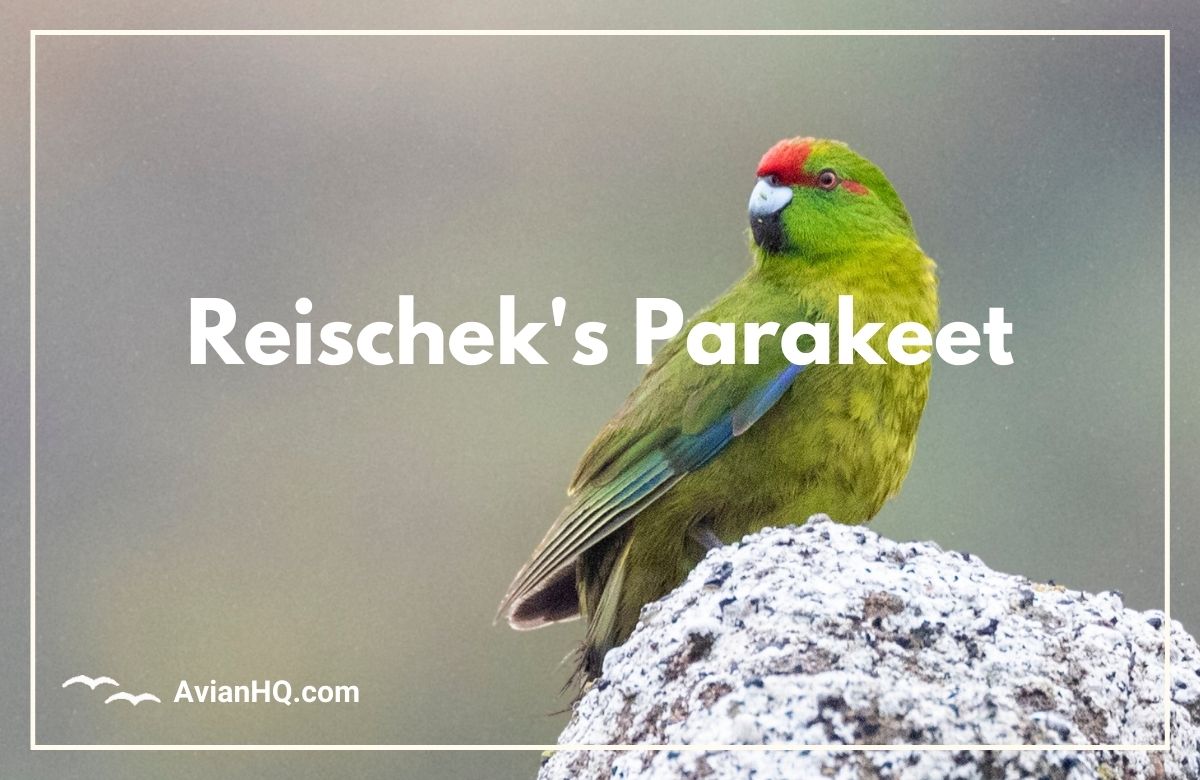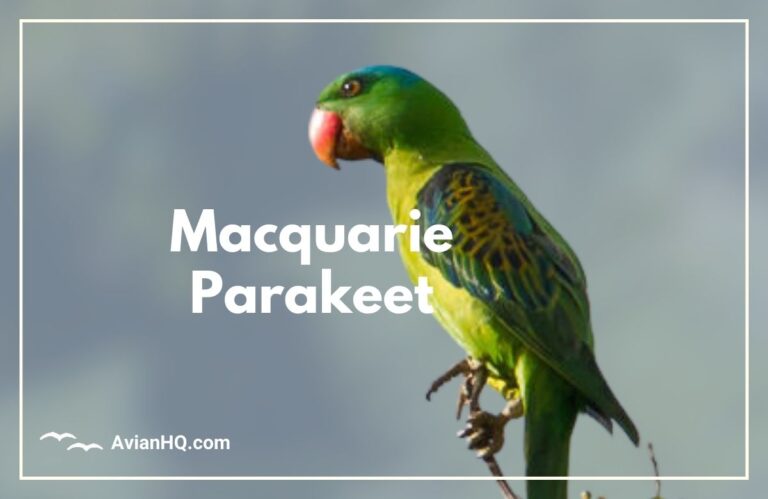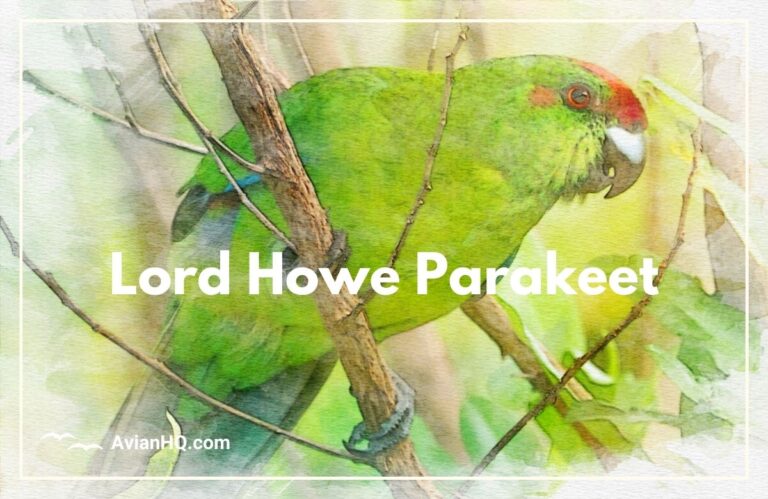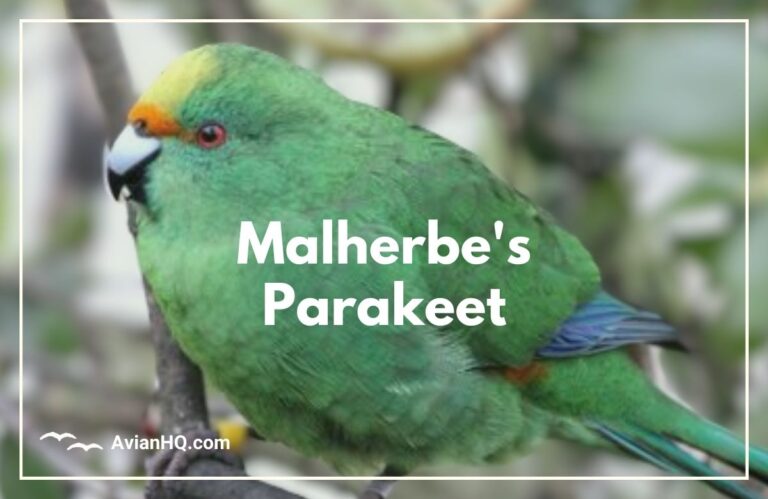Reischek’s Parakeet (Cyanoramphus hochstetteri)
Have you ever seen a bright red and green parakeet flying through the forests of New Zealand? If so, you may have spotted the rare and endangered Reischek’s Parakeet, a species found only on several small islands off the coast of New Zealand.
Reischek’s Parakeets stand out with their bold red foreheads and crowns contrasting sharply with green wings and back feathers. Their scientific name is Cyanoramphus hochstetteri. These rare parakeets inhabit the scrublands and forests on the Antipodes and Auckland Islands, located about 290 miles (467 km) south and 202 miles (325 km) south of New Zealand respectively.
| Island Group | Location |
|---|---|
| Antipodes Islands | 490 km southeast of South Island |
| Auckland Islands | 465 km south of South Island |
Reischek’s Parakeets grow to about 11-12 inches (28-30 cm) in length. They use their distinctive short, deep bills to crack open fruit and extract seeds. You may spot them gathering in noisy flocks that chatter excitedly as they feed.
Unfortunately, Reischek’s Parakeets face threats from habitat loss and predators like rats and feral cats that have been introduced to their island homes. However, conservation efforts are underway to protect these rare New Zealand natives.
In this article, you’ll learn all about the appearance, habitat, behavior, breeding habits, and conservation status of the fascinating Reischek’s Parakeet. We’ll uncover why they have such cultural significance to New Zealanders and what’s being done to ensure their survival. Let’s dive in!
History and Taxonomy
Reischek’s Parakeet has a unique taxonomic history that has only recently been sorted out. These colorful island parakeets were one of the many parrot species originally described by the famous ornithologist Walter Buller in his monumental 1887-1888 book “A History of the Birds of New Zealand”. Buller named the parakeet Cyanoramphus hochstetteri in honor of the Austrian geologist and explorer Ferdinand von Hochstetter.
For over a century afterwards though, taxonomists considered Reischek’s Parakeet to be a subspecies of the more widespread Red-crowned Parakeet that inhabits forests on mainland New Zealand and nearby offshore islands. The credited collector of the first Reischek Parakeet specimens was Andreas Reischek, a sailor and naturalist who was hired to collect specimens on an 1885 scientific expedition to islands off the coast of New Zealand.
It wasn’t until 2021 that modern genetic, morphological, and vocalization analyses finally provided convincing evidence that Reischek’s Parakeet was different enough to be classified as its own distinct species separate from other parakeets. As a result, Reischek’s Parakeet was officially reclassified as Cyanoramphus hochstetteri based on key differences from its mainland relatives:
- Smaller size, only reaching lengths of 11-12 inches (28-30 cm) compared to 13-14 inches (33-36 cm) for Red-crowned Parakeets
- Bright red forehead and crown feathers
- Stockier bill shape
- Unique vocal repertoire of screeching and chattering calls
So while Reischek’s Parakeet remained hidden in plain sight for over 130 years as a subspecies, this rare antipodean parrot can finally stake its claim as a valid endemic species found only on remote islands hundreds of miles off the coast of New Zealand!
Physical Appearance
The most striking feature of Reischek’s Parakeet is its bright red forehead and crown which contrasts vividly with its primarily green and yellow body plumage. These colorful parakeets reach a length of approximately 11-12 inches (28-30 cm) from the tip of the tail to the end of the bill.
The forehead, crown, and nape are a deep orange-red color while the cheeks, throat, and breast are all yellow. The upperparts including the back, wings, rump, and upper tail are generally olive-green. The tail feathers are a blue-green tipping to yellow at the base. The eyes are surrounded by distinctive white or pale yellow eye-rings and the short stocky bill is a grayish color.
Reischek’s Parakeets do not exhibit any sexual dimorphism which means that males and females look identical. Juveniles however can be distinguished from adult birds for up to a year by their duller green plumage lacking the bright red crown as well as their dark grey eye rings and cere.
Field researchers utilize unique color band combinations placed around the legs of Reischek’s Parakeets to identify individuals for monitoring. When seen up close, the subtle barring pattern on the underside of the tail feathers can also be used to distinguish individual birds.
So with its bright crimson colored crown, green wings and back, white eye-rings, and yellow underparts, an unmistakable Reischek’s Parakeet really stands out against the dense green forests it calls home on remote islands hundreds of miles off New Zealand’s shores!
Habitat and Distribution
Reischek’s Parakeets are endemic to remote islands located hundreds of miles off the coast of New Zealand’s South Island in the subantarctic regions of the south Pacific Ocean. Specifically, they are found on the Antipodes Island group as well as the main Auckland Island.
The Antipodes Islands are a collection of small uninhabited islands located about 490 km (304 miles) southeast of New Zealand’s South Island. Meanwhile, Auckland Island itself lies around 465 km (289 miles) south of the mainland. Together these islands have a cool oceanic climate with average summer temperatures around 50°F (10°C) and frequent rain and storms year-round.
On these rugged islands, Reischek’s Parakeets predominantly inhabit broadleaf and mixed forests dominated by species like Antipodes Island Tree Daisy, Antarctic Beech, and Hooker’s Sedge. The parakeets are also common along forest margins bordering scrublands and tussock grasslands.
Researchers estimate the total population to number between 1,000 – 5,000 remaining individuals restricted to their limited island habitats located hundreds of miles from mainland New Zealand. Following successful releases, there are also recently reintroduced populations that have become established on smaller predator-free islands within their former range.
So while humans live in isolation on these remote islands, the rare Reischek’s Parakeets call their temperate forests and scrublands home, having evolved for centuries in this unique island ecosystem.
Diet and Feeding
Reischek’s Parakeets are primarily herbivorous, feeding on a variety of seeds, nectar, fruits, flowers, and buds from native trees and plants. Their short but strong bill allows them to crack into fruits and extract seeds with ease.
Some of the main food sources include the fruits of the Island Tree Daisy, seeds of the Hooker’s Sedge, nectar from flowers like the Auckland Island Daisy, and buds from trees and shrubs like Dracophyllum and Hebe. Additionally, the parakeets will occasionally sample seaweed, herbs, and grasses.
The parakeets forage for food both up in the high canopy as well as lower down closer to the forest floor and scrubland. You can often observe them in small, noisy flocks of around 20-30 birds that excitedly call to each other as they feed. Flocks may also mix with other bird species like the Red-crowned Parakeet, New Zealand Bellbird, and Tui while moving between forest patches.
By dispersing seeds and pollinating flowers of native plants, Reischek’s Parakeets provide vital ecosystem services that help maintain the unique forests they inhabit. Their rediscovered mutual relationship with the carnivorous Auckland Island Pigmyweed is a prime example: the plant provides safe nesting sites for breeding parakeets who in turn fertilize the plant with their nutrient-rich droppings.
So while feasting on berries up high or foraging through low scrub, these colorful island parakeets continue benefitting their limited island ecosystems, much as they have for hundreds of years.
Breeding and Reproduction
Reischek’s Parakeets form monogamous breeding pairs that mate for life. The breeding season generally occurs between November to January. Though research is still ongoing, current data suggests the average lifespan ranges between 15-20 years for these parakeets.
During courtship, breeding pairs engage in mutual preening of their plumage and often present each other with food gifts. Once bonded, the pair collaborates to select a suitable nesting cavity high up in the hollow of an aged tree trunk or large branch. Cavity competition is fierce though and pairs may reuse the same site for consecutive years.
Females typically lay clutches of 4-8 small white eggs within these natural hollows. She will then incubate the eggs alone for 21-24 days before they hatch. The male aids by standing guard and bringing food back to the female while she incubates.
Once all the chicks hatch, both parents share feeding and brooding duties for several weeks. The semi-altricial chicks fledge at around 42 days old but continue to be fed and taught to forage by their parents for some time after leaving the nest. Juveniles wont develop their mature bright red crown plumage until their second year.
With dedicated long-term pair bonds and shared parenting, these colorful parakeets ensure their chicks survive to fledge on their remote island homes off New Zealand.
Behavior and Ecology
Reischek’s Parakeets are highly social and noisy birds that travel in flocks of varying sizes throughout the year when not breeding. Groups can contain anywhere from a few individuals up to several dozen birds foraging and roosting together.
You’ll often hear their chatter and high-pitched screeching long before you see one as flocks excitedly call back and forth to each other. The parakeets make use of a wide variety of different contact calls including loud kee-arr screeches to coordinate flock movements and feeding activities.
Though generally gregarious, breeding pairs do exhibit some territorial behavior, defending potential nesting cavities against other birds in the late winter and early spring. Competition for suitable hollows in old growth trees can be fierce on their native islands.
As cavity nesters, the availability of appropriate nesting sites inside large tree trunks and branches limits their local abundance. Breeding densities vary on different islands based on the stage of forest succession and density of aged trees. Ongoing habitat restoration that preserves old growth trees boosts populations over the long term.
Additionally, pairs appear to have a mutualistic nesting relationship with the carnivorous Pigmyweed plant which provides a safe refuge from predators. In return, the bird’s nutrient rich droppings fertilize the plant. Such unique symbioses underscore the interconnectedness of these remote island habitats.
So whether feeding in noisy flocks or rearing chicks in forest hollows, Reischek’s Parakeets play a key ecological role in their island ecosystem that balances their limited numbers.
Conservation Status
Reischek’s Parakeet is currently classified as Endangered by the IUCN Red List with a small and declining population numbering between 1,000 – 5,000 individuals. Endemic to remote islands hundreds of miles off New Zealand’s coast, their limited range and small population size makes them vulnerable.
Over the last fifty years, the introduction of invasive mammalian predators like rats, cats, and pigs has threatened their survival in native habitats on Antipodes and Auckland Islands. These predators raid nests, killing adults, eggs, and fledglings while also degrading native forest habitats.
In addition, competition for nesting cavities with other bird species combined with habitat degradation from introduced herbivores has reduced available breeding sites. Ongoing monitoring indicates population declines since the 1970s, especially on Auckland Island.
However in recent years, the New Zealand Department of Conservation has taken steps to actively restore island habitats by eradicating invasive predators. Several small offshore islands have now been cleared allowing the successful reintroduction of Reischek’s Parakeets. Establishing new robust populations beyond their current range offers added insurance if disaster ever struck their existing island strongholds.
While still endangered with an uncertain future, active habitat management and the growing success of reintroduction programs provide increased hope that these beautiful parakeets will continue gracing New Zealand’s remote southern islands for years to come.
Cultural Significance
As an endemic species found only on remote southern islands hundreds of miles from mainland New Zealand, Reischek’s Parakeet holds a special place in New Zealand’s natural and cultural heritage.
Its status as a unique parakeet species was recognized in 1987 when the bright red-headed bird was featured on a New Zealand postage stamp along with other native parrots. This celebrated New Zealand’s rare parrot diversity that evolved over millions of years in isolation across scattered southern islands.
Today, ornithologists and birdwatchers from New Zealand make pilgrimages just to catch a glimpse of Reischek’s Parakeet in its remote island homes in the stormy southern oceans. Spotting a flash of crimson crown feathers or hearing its screeching cries provides a tangible connection to wild areas that few Kiwis will ever visit.
More significantly, successful habitat restoration programs reintroducing populations on predator-free islands off Auckland and Antipodes have renewed hope that these rare birds can thrive once more beyond just forest remnants on their original island refuges.
Such reintroduction efforts remind New Zealanders that despite past exploitation, there exist pathways for humans and nature to coexistence sustainably. In this way, the unique Reischek’s Parakeet can help inspire continued conservation of New Zealand’s precious natural heritage that has captivated people’s imagination for generations.
Conclusion
The rare and colorful Reischek’s Parakeet stands out for more than just its bright red crown and green plumage. As an endemic species found only deep in the remote forests of New Zealand’s subantarctic islands, it serves as an important reminder of the precious but fragile native biodiversity that evolved in isolation across these southern archipelagos.
With a global population likely numbering less than 5,000 individuals concentrated densely on just a few islands, they remain an endangered species facing an uncertain future. Habitat degradation from invasive mammals along with competition for nesting sites from other birds threatens their long term survival.
Yet despite these challenges, the success of recent predator eradication and habitat restoration programs offers real hope of a way forward. The populations reestablished on smaller predator-free islands provide insurance populations and may one day offer sources for repopulating their former range.
So while humanity has often been a destructive influence on nature, the story of Reischek’s Parakeet shows pathways yet exist for peaceful coexistence if we have the wisdom to walk them. This rare parakeet can inspire continuing conservation not just of New Zealand’s natural heritage, but of our shared global inheritance for generations to come.







